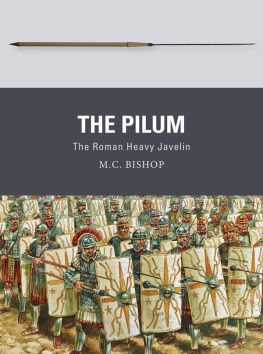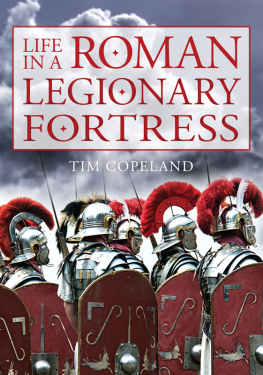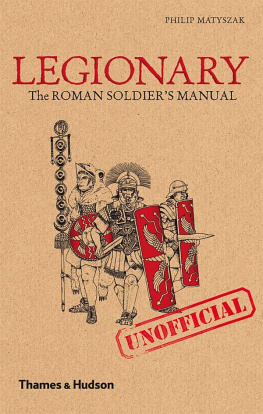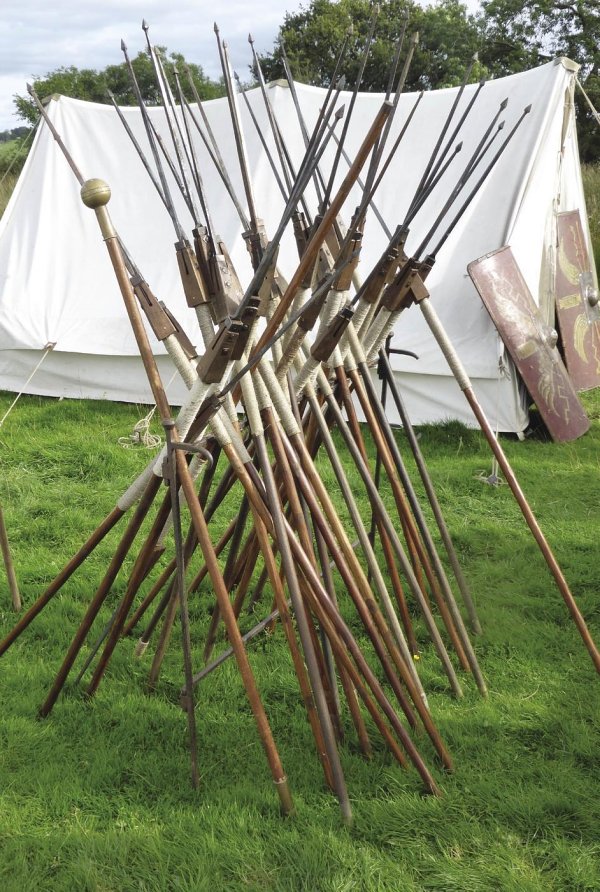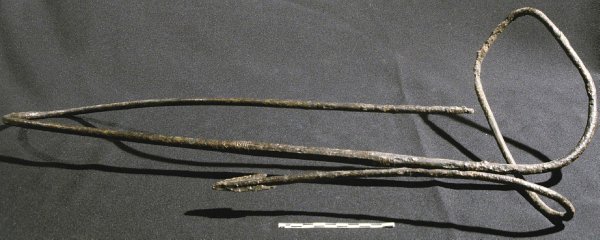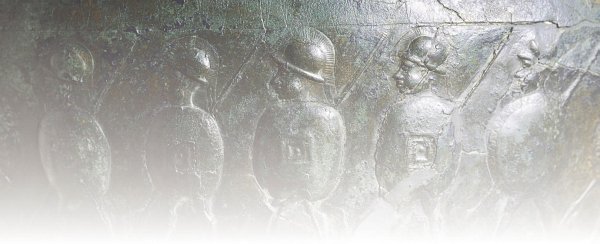
INTRODUCTION
In 58 BC, Julius Caesar confronted a force comprising the entire tribe of Helvetii intent on migrating into Gaul. His troops attempted to stop them:
The legionaries, from the upper ground, easily broke the mass-formation of the enemy by a volley of pila, and, when it was scattered, drew their swords and charged. The Gauls were greatly encumbered for the fight because several of their shields would be pierced and fastened together by a single pilum; and as the iron became bent, they could not pluck it forth, nor fight handily with the left arm encumbered. Therefore many of them preferred, after continued shaking of the arm, to cast off the shield and so to fight bare-bodied. (Caesar, Gallic War 1.25.24)
Re-enactors pila stacked at Birdoswald (England) during Hadrians Wall Live 2015. The pilum, together with the gladius, was unquestionably instrumental in dictating legionary tactics as the Roman Empire grew. The adoption of the manipular, and later the cohort, system of organization was all dependent upon (and arguably shaped by) the interplay of the two weapons and the employment of the pilum volley followed by a charge resulting in hand-to-hand combat with the gladius. It might even be said that these two weapons allowed the average commander to do well and the gifted leader to excel. (Photo: M.C. Bishop)
Those two observations by Caesar that several enemy shields were pinned together and the shank of the pilum bent so it could not be withdrawn have condemned the pilum to being the most misunderstood of all Roman weapons: a javelin designed to stick in an enemys shield. It is not unreasonable, although by no means guaranteed, to suppose that Caesar was an eyewitness to these events and that his account is reliable. Yet the truth behind the function of the pilum nevertheless lies within that short passage: it was indeed designed to pierce a shield, but that was by no means the end of its mission. The long, thin shank was intended to allow the weapon to use its momentum to continue its course and ultimately wound or even kill the unfortunate warrior behind that pierced shield. If it subsequently bent under its own weight and could not be thrown back then that was certainly an advantage, but it was a useful by-product, not the raison dtre of the pilum. What had intrigued Caesar who had presumably seen a lot of pila thrown during his military career enough to cause him to comment was that the Gauls were so close together that their shields overlapped (hence they were fixed together by the pila, which could pass through two).
The pilum was the signature heavy javelin of the Roman legionary infantryman since before the Punic Wars under the Republic until well into the Imperial period. Like musket volleys immediately before more recent armies clashed on the battlefield, a volley of pila was designed to weaken the impact of an enemy attack by disorganizing their front ranks, allowing the legionaries to get to work at close quarters with the gladius. In common with earlier, javelin-equipped armies on the Italian peninsula, Roman legionaries originally carried two pila, which were part of the legionary package of weapons, together with the short sword and shield, used in a carefully synchronized and choreographed sequence. The legionary would throw his pilum and while it was probably still in flight draw his sword ready for the next stage of the attack. The impact of the javelins would therefore rapidly be followed by contact between the two forces. Although its design made it very difficult for an enemy to reuse it quickly, once a battle was won and the damaged weapons retrieved, the pilum could nevertheless be returned to a serviceable state with the minimum of effort and expertise by a Roman legionary without necessarily needing the facilities of a forge.
The pilum underwent a series of developments during its period of use by the Roman Army and several distinct variants are apparent as well as two very different methods of hafting it. A number of different types of head were tried, and representational evidence indicates that weights were added to improve penetrative power and throwing straps employed to increase range, but the essential form of an iron (consisting of head, shank and tang or socket) on a wooden shaft remained unchanged. However, it is abundantly clear that, at any given period, there was no one type of pilum in use, but rather a range of forms which gradually evolved over time. Perhaps the most telling development of all the volley itself was a uniquely Roman contribution, since it relied on organizational skills and a level of training that were to be found in few other armies in the ancient world. The sources both literary and representational also emphasize the pilums versatility, making it clear that it was not just used as a javelin and that legionaries quite happily employed it as a thrusting spear when necessary, even being prepared to receive a cavalry charge with it.
The question of the origin of the pilum has occupied scholars since the 19th century and has not been helped by the fact that the Romans themselves seem to have forgotten (or, at best, become confused about) how they acquired this distinctive weapon. One thing is certain: like most of their military equipment, the Romans inherited the pilum from one (or more) of the peoples against whom they fought and then made it their own. What is furthermore apparent is the legacy of the weapon in the Late Roman and Early Medieval periods, when its descendants found favour with various armies. Finally, its iconic role as a traditional Roman weapon achieved a degree of fame in Hollywoods movie depiction of Rome. Along with the short sword and curved body shield, for many people the pilum still epitomizes the Roman legionary. The combination of the three made Romes heavy infantry a force to be reckoned with.
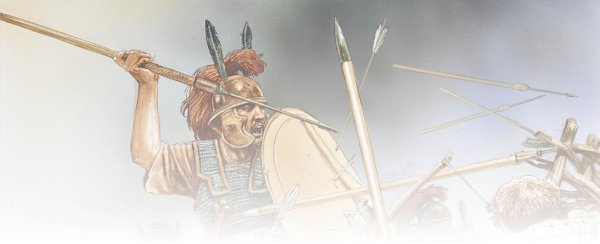
DEVELOPMENT
Adopt then adapt
ORIGINS
A soliferreum from Tzar-Moclin, Spain. (Photo: F. Quesada Sanz)
The Roman habit of adopting and adapting enemy weaponry was well known, but one detail puzzled modern scholars: which weapon served as a model for the first Roman pilum? This simple question led to a dispute between two of the great archaeologists of the early 20th century, the Frenchman Adolphe Reinach and the German Adolf Schulten. Writing in 1907, Reinach believed the pilum to have had a Samnite origin and suggested that it was adopted by the Romans shortly after the Samnite Wars in the second half of the 3rd century BC. In contrast, Schulten, writing in 1914, preferred an Iberian origin, and felt that it was adapted from (what the Romans called) the solliferr(e)um and adopted at the same time as the gladius Hispaniensis, towards the end of the 3rd century BC. It is worth pointing out that Schulten had conducted an important series of excavations on the Roman siege works around the hilltop town of Numantia in Spain, so his advocacy of an Iberian origin is scarcely surprising, given the nature of the material he found there. Unlike the

